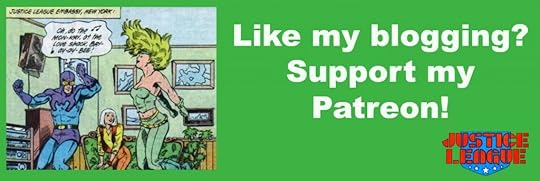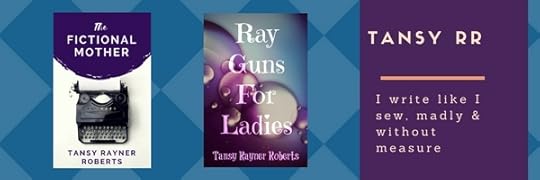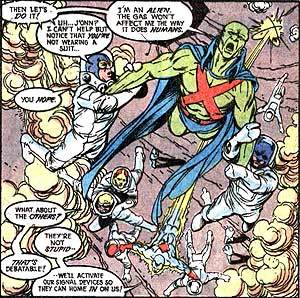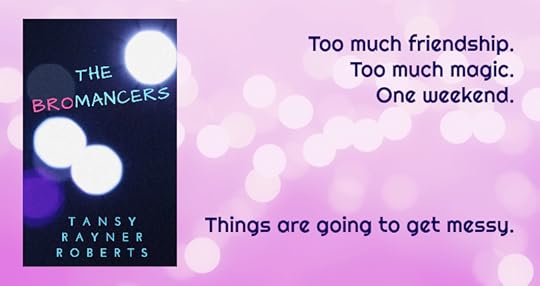Tansy Rayner Roberts's Blog, page 10
October 5, 2017
Favourite Read: Tam Lin (and The Piper)
 Over and over I tell people that one of my favourite books to read and reread is Tam Lin by Pamela Dean. This gorgeous story of book reading, faerie lore, haunted buildings and crunchy autumn leaves, is the book that basically ruined university for me before I even got there, because the real experience could never compete with the haze of nostalgic Shakespeare-adoration.
Over and over I tell people that one of my favourite books to read and reread is Tam Lin by Pamela Dean. This gorgeous story of book reading, faerie lore, haunted buildings and crunchy autumn leaves, is the book that basically ruined university for me before I even got there, because the real experience could never compete with the haze of nostalgic Shakespeare-adoration.
[Reader: I became a Classics student. I regret nothing.]
Tam Lin is a historical novel about being a liberal arts student in the 1970’s, falling in love with your university, first boyfriends, best friends, theatre, birth control, and oh, fairies. The magical elements of this novel is such a slow boil that the you get past the middle of the story before the frog is even warmed up, but oh it’s worth the wait.
I read it in my teens and over and over through adulthood. It must be a good 13 years since I read it last (my big rereading binge when I was pregnant with my eldest) but I’m starting to feel that it’s time again… even if I basically know every word and scene and character by heart.
If you haven’t read this before… it’s so good! If you enjoyed Jo Walton’s Among Others, or anything by Diana Wynne Jones or Catherynne M Valente, I think you’ll get something out of it.
If like me, you already know you love Tam Lin, then consider pledging to Pamela Dean’s Patreon to help keep her head above water as she works on finishing and self-publishing her new novel.
Recently someone recommended I read this fanfic sequel, The Piper, which is gorgeous. Set in the 1980’s and capturing the same tone as the original, this tells of Janet’s two younger siblings, facing down Professor Medeous and the faery tithe seven years later. It reminded me of everything I loved about Tam Lin.
October 3, 2017
Sheep Might Fly: Did We Break The End of the World Part 4
Get the new episode here!
“Did We Break the End of the World” was first published in the excellent anthology of disability & apocalypse: Defying Doomsday, edited by Tsana Dolichva and Holly Kench.
Check out the Sheep Might Fly Master List: we’re up to 9 complete story serials on this podcast!
Also check out my new podcast, Frankentastic, a regendered reading of Mary Shelley’s Frankenstein.
If you missed it:
Did We Break The End of the World Part 1
Part 2
Part 3
You can sign up to my author newsletter for updates, follow me on Twitter at @tansyrr or @sheepmightfly, find me on Facebook at TansyRRBooks, and if you like this podcast consider supporting me at Patreon where you can receive all kinds of cool rewards and exclusive stories.
September 30, 2017
Sheep Might Fly: Did We Break The End of the World Part 3
Stream or download the new episode here!
“Did We Break the End of the World” was first published in the excellent anthology of disability & apocalypse: Defying Doomsday, edited by Tsana Dolichva and Holly Kench.
You can sign up to my author newsletter for updates, follow me on Twitter at @tansyrr or @sheepmightfly, find me on Facebook at TansyRRBooks, and if you like this podcast consider supporting me at Patreon where you can receive all kinds of cool rewards and exclusive stories.
Check out the Sheep Might Fly Master List: we’re up to 9 complete story serials on this podcast!
Also check out my new podcast, Frankentastic, a regendered reading of Mary Shelley’s Frankenstein.
If you missed it:
September 19, 2017
Justice League America 32: Breaking Point (Nov 1989)
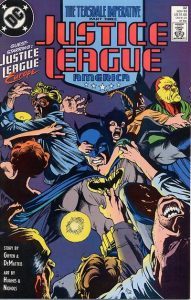 THE PACKAGING: JLI Vol 6.
THE PACKAGING: JLI Vol 6.
THE CREATIVE TEAM: Keith Giffen (Plot & Breakdowns), J.M. DeMatteis (Script), Adam Hughes (Pencils), Joe Rubenstein (Inks), Gene D’Angelo (Colors), Andy Helfer (Editor) Kevin Dooley (Assistant Editor)
CROSSOVER ALERT: The Teasdale Imperative 3/4
JUSTICE LEAGUE ROLL CALL: J’onn J’onzz the Martian Manhunter, sometimes Batman, Green Lantern (Guy Gardner,) Fire, Ice, Blue Beetle, Booster Gold, Mister Miracle (Scott Free), Huntress (Helena Bertinelli) & Dr Fate (Linda Strauss) with no sign of Maxwell Lord & Oberon in civilian support.
GUEST STARS: From the JLE: Power Girl, Captain Atom, Metamorpho, Elongated Man (Ralph Dibny), The Flash (Wally West), Animal Man, Rocket Red (Dmitri Pushkin). Also: Teasdale, Simon Stagg, the Gray Man, The Spectre.
THE STORY: So we get a lot of Teasdale explaining his motivations in this issue which — yawn. He’s a mad scientist pure and simple, and while there’s some meta commentary about the nature of mad scientists, that isn’t really enough to justify quite so many pages dedicated to this bozo.
The twist is that the experiments Teasdale did which led to him creating an army of zombies (yep they’re zombies now apparently not vampires, though still quite bite-y) were funded and encouraged heartily by Simon Stagg, AKA Metamorpho’s Dad-in-law. Teasdale is now rampaging his way through the Balkans, apparently out of revenge for Stagg… doing something.
It’s all very rampagey.
Simon Stagg lets the JLE & JLA know that by fighting Teasdale they’ll be helping him out a lot, but sadly they pretty much have to do it anyway.
It’s the calm before the storm, I guess? Not much happens.
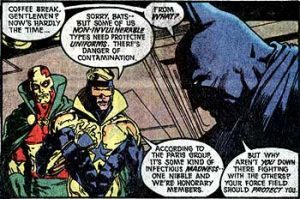 THE CHARACTERS: The strength of this crossover is not the super boring plot (the Gray Man has to be the worst antagonist of all times, he just stands around and makes unerwhelming, slightly mystical threats to the universe), but the character moments in between. It’s nice to see the JLE & JLA mixing things up a bit.
THE CHARACTERS: The strength of this crossover is not the super boring plot (the Gray Man has to be the worst antagonist of all times, he just stands around and makes unerwhelming, slightly mystical threats to the universe), but the character moments in between. It’s nice to see the JLE & JLA mixing things up a bit.
There’s an ominous scene between Mister Miracle and Power Girl — he’s miserable that they’re dealing with a plot that reminds him of his childhood trauma, and wishing he was at home in his sleepy suburban town with Barda and their business. Yep, the writing is clearly on the wall for Scotty-boy. When Power Girl tries to get him to use his expertise against the zombies, he loses his temper.
And of course when Simon Stagg is around, Metamorpho has a lot of anger to work through.
Flash takes a break from sexually harassing Power Girl to hit on Ice, who shuts him down thoroughly. (She has to do the same with Guy, yet again, in the same issue). I’m really loving how Tora is being written now. She’s often remembered as being the soft squishy one, all hearts and puppies and dedicated nerdery in comparison to Fire’s wild, more impulsive antics. But one of the key features of Tora is — she’s sarcastic as hell!
She has to have a lot of patience to deal with Fire as her best friend, but that doesn’t mean you can walk all over her. I love the snarky comebacks she has for the men who won’t leave her alone, even though that trope is getting super boring.
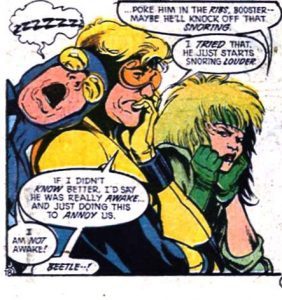 THE COMEDY: Like the character stuff, the comedy in this issue comes from the quiet moments, as well as some classic battlefield banter. It’s all good stuff, and the dynamic between the two super teams is great.
THE COMEDY: Like the character stuff, the comedy in this issue comes from the quiet moments, as well as some classic battlefield banter. It’s all good stuff, and the dynamic between the two super teams is great.
Best by far is a single panel in which Beetle snores on Booster’s shoulder, annoying Fire so much she thinks he’s faking it… and of course, he is.
Blue Beetle and Fire pulling this kind of shit with each other is actually one of my favourite character dynamics of this era of comics. Booster & Beetle are iconic, as are Fire & Ice, but I really like other combinations of those four, too.
Unfortunately so much of this issue is either The Spectre and the Gray Man being all mournful, mystical and failing to move the story forward, or the crazed Teasdale capering about the place like a less entertaining blueprint for Dr Doofenshmirtz.
I do wonder if part of my boredom comes from the fact that all the meta jokes about mad scientists & super-villains are well and truly played out in 2017, thanks to The Incredibles and Phineas & Ferb and everything in between. Were they original and clever in 1989? I don’t even know.
THE ART: Adam Hughes isn’t really being shown off at his best here, with so many long shots and not nearly enough facial close ups … except for Teasdale who is a great design but takes up far too much space.
It’s so, so lovely to see Power Girl drawn by someone who isn’t Bart Sears, though. And all the glimpses of the all-new Fire and Ice make me comforted and happy.
THE KITCHEN SINK: The Spectre is far too earnest to be part of this comic. He’s sucking all the air out of the scenery.
September 18, 2017
Sheep Might Fly: Did We Break The End of the World Part 2
Stream or download this episode now!
“Did We Break the End of the World” was first published in the excellent anthology of disability & apocalypse: Defying Doomsday, edited by Tsana Dolichva and Holly Kench. This story was nominated for two Aurealis Awards, and won the Ditmar for Best Novella/ Novelette.
You can sign up to my author newsletter for updates, follow me on Twitter at @tansyrr or @sheepmightfly, find me on Facebook at TansyRRBooks, and if you like this podcast consider supporting me at Patreon where you can receive all kinds of cool rewards and exclusive stories.
Check out the Sheep Might Fly Master List: we’re up to 9 complete story serials on this podcast!
If you missed it:
Did We Break The End of the World Part 1
September 7, 2017
The Fictional Mother
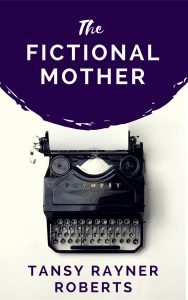 This was first published in an essay collection, also called The Fictional Mother, which I released as a bonus reward for my patrons in May 2017. You can access this collection and a whole bundle of other e-books, along with other rewards, by pledging $1 or more to my Patreon every month.
This was first published in an essay collection, also called The Fictional Mother, which I released as a bonus reward for my patrons in May 2017. You can access this collection and a whole bundle of other e-books, along with other rewards, by pledging $1 or more to my Patreon every month.
Spoilers for Season 5 of Buffy, Seasons 3 & 4 of Once Upon a Time.
Potentially triggering discussion of cancer diagnosis & treatment as well as maternal deaths in fiction & real life. Take care of yourselves.
_________________
(Don’t panic)
In 2016, I was diagnosed with a low-grade skin lymphoma, after a biopsy on my forehead. It was surgically removed.
(Seriously, don’t panic)
One year and a second positive biopsy later, my cancer was officially graded as ‘recurring’ though this was also matched with more comforting words such as ‘indolent.’ After a second round of invasive tests and scans during which I learned that my body finds contrast dye physically repellent (literally) I am now facing down a month of radiotherapy. This, I have been assured, is very boring and has a high success rate for curing specific cancers. Over the last year, I have lurched between times of extreme anxiety about my health and my future, moments of cautious relief, and even twinges of guilt that this is such a small health crisis compared to those of others.
(Everything’s gonna be OK)
Yep, I actually feel guilty that my cancer is so discrete and treatable. How’s that for imposter syndrome? This time around, though, it feels a lot more real than it did last year. And every time I explain to people how extremely small and treatable and really no big deal my cancer is, it feels like I am thumbing my nose at fate. So. There are a lot of feelings.
(On a related note, hey, if you have the chance to get regular check ups at your local skin clinic, why not go do that? Tell your friends!)
Back when we were waiting for the original diagnosis, I thought a lot about my daughters, and my mind kept being drawn to Disney movies. The possibility of dying (it’s horribly easy to leap from ‘cancer’ to ‘dying’ in a single panicked second, especially if you’ve been Googling all the words your doctor uses without context) becomes a whole different kind of scary when you are a parent.
(Spoiler: I’m not currently dying except in the sense that I am, apparently, mortal.)
The thought of leaving my daughters behind, of being their tragic backstory, of being one of those Disney mothers who dies in the first five minutes of the movie (or indeed, before the movie even starts) was incomprehensible to me, and it sent me into an anxiety spiral.
Before I had our first child, my partner and I used to watch ‘Friday Night Crime’ on the ABC, all those forensic, pathologic, murderous dramas that were so prevalent in the mid-2000s. Once we had a baby in the house, we had to stop watching those shows, because of the fictional use of dead babies and children, over and over again, for emotional effect. It wasn’t something we could deal with, in our foggy bliss as exhausted but protective new parents. So we turned off the TV.
After my first cancer diagnosis, it suddenly felt like every story I read or watched was about dead mothers.
The stories weren’t about the mothers at all, most of the time. But many of them happened to be about daughters or sons who had been wounded or damaged or emotionally scarred by the loss of a mother, while they were young. Every time I came across another story about a dead mother, it felt like I was being stabbed in my tiny surgical wound all over again.
The reason these stories are so prevalent in fiction, of course, is because they do happen in real life.
My own family’s history reflects that: both my parents lost their mothers at cruelly young ages, and it has affected them strongly (though differently) throughout their lives. Many dead mother stories, both real and fictional, are authentic and sensitive and touching. I would never demand that those stories be left unwritten.
But I didn’t want to read or watch them this last year; I couldn’t deal with them. I also couldn’t avoid them.
I’ve recently been rewatching Buffy with my daughter R, who at 12 is seeing it for the first time. She coped far better than I did with the significant deaths of the show, and especially with the iconic, famously gut-wrenching episode, “The Body”.
Last time I watched Buffy, losing my mother was the one of the worst things I could imagine, and that is still true. But this time around, I identified with Joyce Summers, not Buffy. I had forgotten how much of that season deals with Joyce’s medical issues before her almost-casual moment of death. Trying to comfort and protect your children when you’re the one going through the physical wringer? Fear at leaving them behind? Oh yes. Right there with you, Joyce.
The thought of not being there for my kids through their entire childhoods made it hard for me to breathe, while I was waiting for my scary test results. It certainly made it impossible for me to enjoy a story based on that trope. Those stories are not for me. The mothers don’t have to die to make me feel that way; a traumatic separation is enough to trigger my own fears. This was true even before last year’s diagnosis. Now, it’s extra-true. Super true.
(As previously mentioned, I am not currently dying)
It’s rare for me to find living figures of motherhood and parenting in fiction that I can fully identify with, especially in science fiction and fantasy: parenting is often erased from or concealed from the main narrative. Mothers and babies are killed off in the background, or the babies are magically aged/separated from the hero-mothers so as not to drag the story down with domestic routine. I get so frustrated with the stories (especially in TV, the worst culprit for this trope) that engage a pregnancy storyline for maximum feels, only to magically age or time-jump the kid so we skip past ALL THE RELEVANT TO MY LIFE PARTS.
Why yes, I am a writer myself. Why yes, I do know that the best way to find true representation in fiction is to write it yourself. Why no, I have not written much about motherhood at all in my fiction. Why not, you ask? That is a very good question. More on this later.
Occasionally I find fictional mothers who feel at least a little bit like me in science fiction or fantasy: characters who juggle ongoing parenting commitments with the work of saving the world. They hide in the margins of stories for the most part, though a few stride across the screen in comfortable boots (thank you, Gwen Cooper of Torchwood). In Once Upon a Time, the character of Mary-Margaret/Snow White is a key victim of the “lost my baby’s childhood” trope as part of the show’s original premise, but I was pleased to see her allowed a destiny-life balance with her new baby in Season 4. I haven’t yet watched the later seasons and don’t know what the follow-through has been like. Cautious optimism, people.
Saga, the space opera comic, is a rare example of fiction where the messy aspects of parenting a baby are combined with drama, action, war and adventure. It’s a special snowflake in a universe of media that assumes parenting has to be boring.
I also love what Yonderland, an excellently silly British TV fantasy with puppets, does with their “Chosen Mum,” a hero who discovers her special destiny during that surreal, isolating period just after her children start full-time school. Her fantasy adventures are a metaphor for returning to the workforce after being a full time parent, still trying to hold those two separate universes in your head. It’s especially marvellous how Yonderland turned that time period when the kids are in school – the mythical “me time” for a mother – into a liminal fantasy portal.
Let’s get back to how I’ve been a mother for more than twelve years, and I haven’t written about it. Sure, I blogged around the births and early childhoods of both kids: sleep deprived and anxious, I poured out my frustrations and fears and squishy emotions into Blogger, Livejournal, WordPress. I talk everyone’s ears off about my maternal experience, both in person and via podcasts. The lens through which I view pop culture criticism has sharply altered as my kids grow up, because I’m not only looking for entertainment to represent me, I’m looking for what the world of fiction is throwing at my daughters in the way of heroes, gender roles, toxic tropes and problematic politics.
When I say I haven’t written about motherhood over the last twelve years, I’m talking about fiction. When I started my “big” fantasy trilogy The Creature Court, I was determined to write a ‘chosen one’ story about a woman who was already established in her life, with friends and a job. Not a Buffy-type teenager just getting started. The disruption is far more real if your magical awakening is not also a coming of age story.
I was young enough that ‘established in her life’ meant Velody was in her late twenties, working in a trade she loved. Not a partner or a mother. By the time I’d finished the trilogy, I was a mother of two, but I hadn’t let those life changes infuse my work.
I have written short stories about motherhood. I did this deliberately during the babyhood of each of my daughters, trying to capture that feeling of having a baby in my arms, knowing it was an experience I would not remember as intensely or viscerally later on. My mother always claims she has next to no memories of the first three years of my life, so I had a head’s up that my brain might not be the most reliable archive.
In “The Scent of Milk,” which I wrote when my first daughter R was small, I tried to capture my emotional state at being so completely in thrall to a tiny person, never wanting to miss a moment with her. I had been shaken badly by a stolen baby story in the news while I was pregnant. The fact that the mother was separated from her baby for days wrecked me.
I fed this anxiety into a story about changelings. When I look at that story now, it does indeed feel like it was written by an exhausted, paranoid stranger.
I was less overwhelmed by my second baby J’s birth — it wasn’t quite as dramatic a reboot of life and identity. I was in the middle of writing that fantasy trilogy that had nothing to do with babies, and the story I wrote about J’s babyhood is “Relentless Adaptations,” in which motherhood is a background experience of a larger story. Still, I captured details that feel authentic to the person I was then, so long ago now.
None of the main protagonists of my novels have given birth, or been mothers in anything but a vague ‘someday future’ – Kassa Daggersharp, Tabitha Darling, Velody, Dana D’Artagnan. (I have paid more attention to my heroes becoming fathers, which is – kind of an interesting thought for me to mull over.) Love and Romanpunk, my short story collection about monsters, is probably the closest I’ve come to the point of view of mothers, though I don’t connect the mothers in those stories to my own experience — this is probably a good thing, considering Agrippina’s disturbing relationship with her son Nero.
More recently, my writing has skewed “young” again. My protagonists circling the late teens, early twenties age group. I just finished writing “Girl Reporter,” a mother-daughter novella, but it’s told from the daughter’s perspective. I have a ‘dead/refrigerated mother’ story to be addressed in my Castle Charming stories, but I’m not there yet.
Being a mother is integral to my sense of self, both public and private. We’re long past the point that my eldest daughter is comfortable with me mentioning her online at all, which is something I have to come to terms with: how does my need to discuss motherhood intrude upon her right to privacy?
But if my identity as a mother is so important to me in other aspects of my life, including the consuming and critiquing of fiction, why don’t I put myself in the fiction that I write?
What am I waiting for?
When the whole ‘cancer’ word first reared its head, and I had finally got over myself about the whole Disney mother business (really, Tansy? Overdramatic much?), one of the other things I thought about a lot was my legacy.
I turn 40 next year, and will celebrate the first 20 years of my career as a published writer. Also, I’ve spent the last 18 months listening to the Hamilton soundtrack “non-stop”, so it’s not surprising that legacy is on my mind.
It has felt empowering, allowing myself to think of my career and my writing in those terms. To consider the legacy I would leave behind, rather than the smaller, more reasonable goals I worried about before:
Can this earn me a living?
Will anyone read it?
Can I break into the US markets?
Do awards even matter?
It was a much-needed kick in the pants, not necessarily to write more but to choose my projects more wisely. To stop holding back. If there’s something I need to write, why delay?
(Who lives, who dies, who tells your story?)
(Please let me reiterate that I am not dying)
I have some big writing projects swirling in my head, waiting for me to admit that I’ve levelled up, and I’m ready to tackle them. Both projects involve female protagonists whose motherhood is a key part of their identity, their past and their future. I should go ahead and write those books. They’re mine, my stories, and I want them on paper.
One of them is my Inevitable Great Livia Novel, which I have wanted to write for a decade or more. It involves weaving and magic and Ancient Roman politics and pregnancy sex. One of her sons constantly disappoints her; the other dies tragically young.
The other is about a mother who believes she is dying: she has a curse which makes lines of poetry appear on her skin, and when the entire poem is complete, her time is up. She visits temples in secret to have the lines of poetry cut out; if she gets to them fast enough, she buys herself a little more time. Long enough, perhaps to secure her daughter’s future? I came up with the idea at roughly the moment I was going through my first biopsy, having a piece of myself literally cut away so that it wouldn’t try to kill me later down the line.
I don’t know if I quite have the emotional fortitude to tackle either of those books yet. But I’m not going to wait too long.
You only get to write so many stories, in this life. Better make them count.
_______________________
UPDATE: It’s now September, I’m on the other side of treatment which was totally 95 parts boring to 5 parts scary. Thank goodness for socialised healthcare in Australia! 20 courses of radiotherapy didn’t cost me a cent though I did spend a lot on bubble tea that month. We’re pretty sure I’m currently cancer-free, though I’ll be having regular checks over the next several years. I also have a new addiction to hair scarves because of my new irradiated bald spot on my forehead! All was well.
September 6, 2017
Justice League Europe #7: Teasedale Unbound
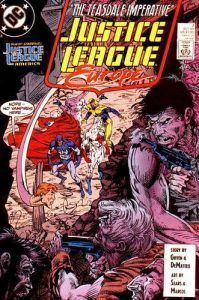 THE PACKAGING: Volume Six of the JLI trades
THE PACKAGING: Volume Six of the JLI trades
THE CREATIVE TEAM: Keith Giffen (Plot & Breakdowns), J.M. DeMatteis (Script), Bart Sears (Pencils), Pablos Marcos (Inks), Gene D’Angelo (Colors), Andy Helfer (Editor)
CROSSOVER ALERT: The Teasdale Imperative. Remember when crossover events happened just between 2 sympathetic titles, and were written by the same team so you had consistency? Sigh.
JUSTICE LEAGUE ROLL CALL: Captain Atom, Metamorpho, Elongated Man (Ralph Dibny), The Flash (Wally West), Power Girl, Animal Man, Rocket Red (Dmitri Pushkin), with Catherine Cobert and Sue Dibny in civilian support.
GUEST STARS: From the JLA: J’onn J’onzz the Martian Manhunter, sometimes Batman, Green Lantern (Guy Gardner,) Fire, Ice, Blue Beetle, Booster Gold, Mister Miracle (Scott Free) & Dr Fate. Also: The Spectre, the GREY Man & that Teasdale dude.
THE STORY: The JLA arrive to find the JLE in the middle of a pitched battle against crazed, violent villagers who… well, not to roll out the ‘v’ word but, they’re kinda acting like vampires, right? With the biting?
Most of this issue’s dialogue consists of a series of debates about whether these villagers are actually vampires or not. It’s pretty great.
We get a bunch of backstory about how the JLE ended up battling European “vampires” which is pretty much — they got a mission called in, they went, turned out that the peeps were bite-y. Not sure we needed the flashback.
Still, it’s nice to see the JLI actually using hazard suits in the face of potential contamination. That’s more than we get from most crime shows these days. Toward the end of the issue we get a glimpse of the mysterious ‘Teasdale’ who is rocking a hermit mad scientist vibe, and — intriguingly — blames Stagg (remember Simon Stagg, Metamorpho’s weirdo father-in-law?) for his situation.
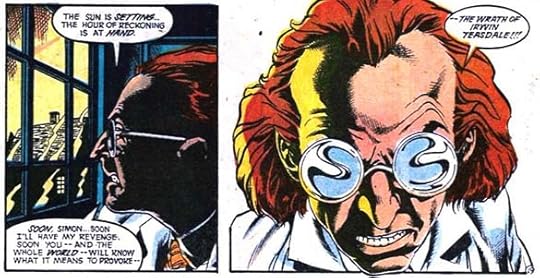
THE CHARACTERS: Some lovely conversations in this one. I particularly enjoyed Fire and Power Girl getting a couple of pages to muse on the dynamics of superhero teams, without specifically talking about the dudes. Superhero women being friends and sharing deets! Love it!
There’s also some nice stuff between Ralph & Batman, acknowledging their shared history. The tensions between Captain Atom and J’onn are great.
There’s a wistful!Buddy scene between he and Dmitri that shows once again that Buddy is not cut out for this comic. He doesn’t want to be here.
THE COMEDY: As with the previous issue, the humour here feels very natural and comes out of the characters. Metamorpho being a wall, the exhaustive vampire banter, Dr Fate’s continual bemusement at the JLA antics (there’s always one) etc.
THE ART: OK this might be the comic book equivalent of Stockholm Syndrome, but this issue wasn’t that bad. I am still constantly outraged by the werd hunchback red cloak effect that Sears gives to Power Girl, but his action sequences are dynamic, and his Captain Atom is a thing of beauty. Basically if he is called on to do powerful flight, fight scenes, male muscles or gritty film noir faces, he’s fine.
The creepy horror themes of this comic are clearly a lot more in Sears’ wheelhouse than the brightly-coloured comic set pieces we’ve had in JLE so far… but um, this isn’t a horror comic, so.
Also there’s one panel where the Martian Manhunter’s head is so CLEARLY the shape of a penis that I can’t even.
THE KITCHEN SINK: I was annoyed at first that they were calling him the Grey Man instead of the Gray Man which was literally what he was called last issue — I’m all for ditching US spelling but weird continuity glitch much? Then I realised he’s probably the Grey Man in this issue because THIS IS JUSTICE LEAGUE EUROPE and then I laughed and laughed.
September 4, 2017
The Bromancers: it’s a book!
My new novella The Bromancers is available to download this month, only to patrons. You can become a patron at any time for as little as $1 a month – at $2+ you get exclusive stories and access to the Galactic Suburbia Slack!
The Bromancers will go on general sale later in the year. It’s part of the Belladonna University series of stories which also includes “Fake Geek Girl” and “Unmagical Boy Story.”
Featuring: epic BFFs, obsessive fans, camping is the worst, basilisks make terrible parents, smooches, snark, geeky music, obsessive coffee (and not coffee) drinkers, even magical camping is the worst, broomsticks, cauldrons, silk shirts, tragic backstories unlocked, and a brand new Fake Geek Girl song (eventually).
Sheep Might Fly: Q&A with Tansy
In this week’s special episode, I answer questions about the podcast and my recent stories from listeners.
Thanks to Mieneke, Sidsel, Mel, Ju & Faith for your questions!
Come back next week for the beginning of a new story, Did We Break The End of the World from Defying Doomsday, which won the Ditmar this year for Best Novella.
You can sign up to my author newsletter for updates, follow me on Twitter at @tansyrr or @sheepmightfly, find me on Facebook at TansyRRBooks, and if you like this podcast consider supporting me at Patreon where you can receive all kinds of cool rewards and exclusive stories.
Check out the Sheep Might Fly Master List: we’re up to 9 complete story serials on this podcast!
You can also comment on this podcast! Let me know what you thought, or if you have a better answer than I do for the Fake Geek Girl casting couch question. (it wouldn’t be hard to answer this one better than I did) Send questions my way if you want more Q & A podcasts in the future.
September 3, 2017
Galactic Suburbia Episode 174
In which Alisa & Tansy talk #ownvoices, the nuance of diversity and the current trend for “authenticity” at the expense of author privacy.
WHAT’S NEW ON THE INTERNET?
Yoon Ha Lee on #ownvoices & being outed as a trans author
Follow up from D Franklin on how authors of marginalised identities aren’t beyond criticism when writing about toxic or damaging tropes.
Corinne Duyvis & the origins of #ownvoices and its original intentions.
CULTURE CONSUMED:
Alisa: the news, the weather & PhD stuff
Tansy: In Other Worlds, Sarah Rees Brennan; A Taste of Honey, Kai Ashante Wilson
Check out Tansy moonlighting on the Fangirl Happy Hour podcast!
Please send feedback to us at galacticsuburbia@gmail.com, follow us on Twitter at @galacticsuburbs, check out Galactic Suburbia Podcast on Facebook, support us at Patreon – which now includes access to the ever so exclusive GS Slack – and don’t forget to leave a review on iTunes if you love us!

